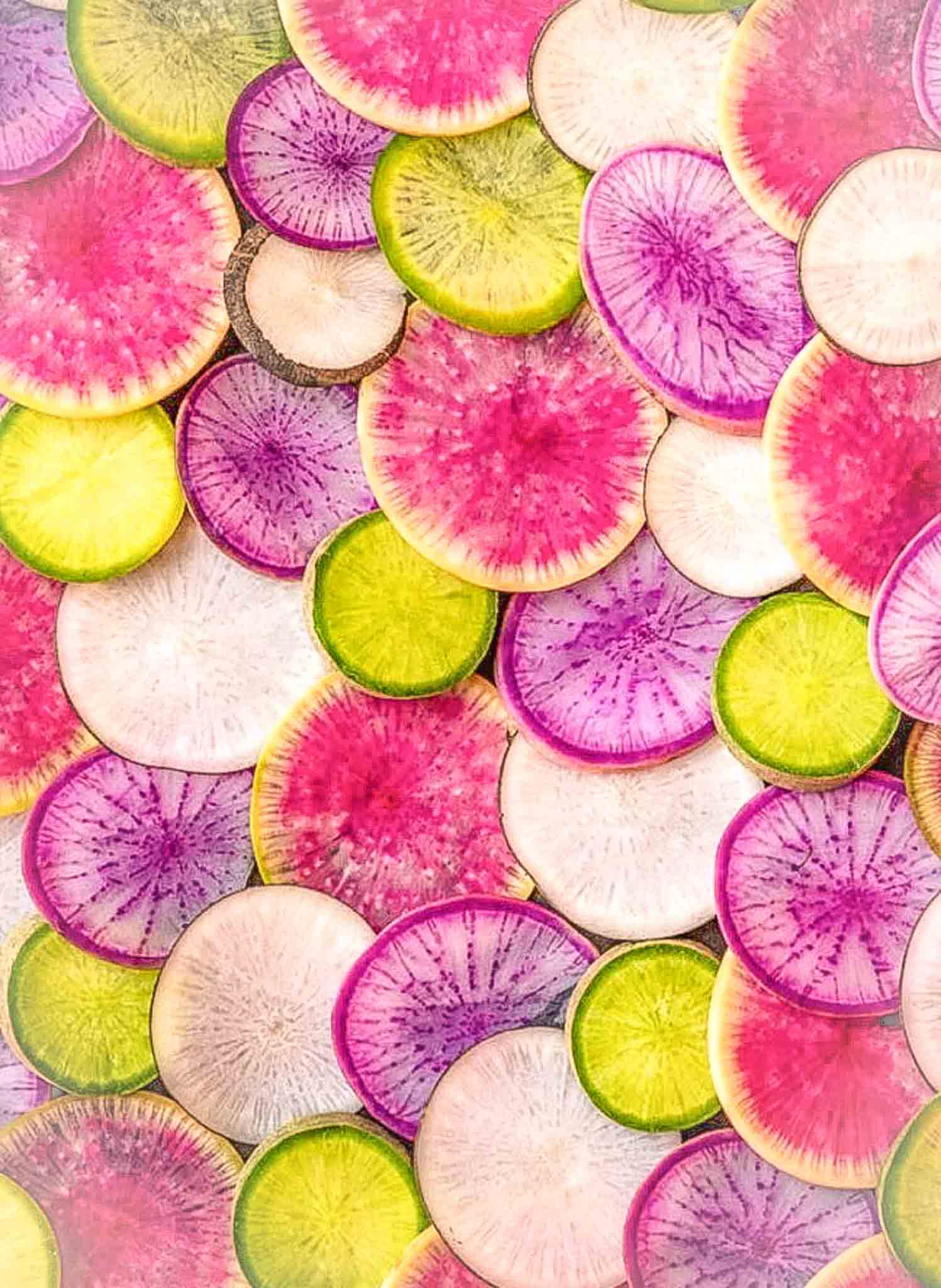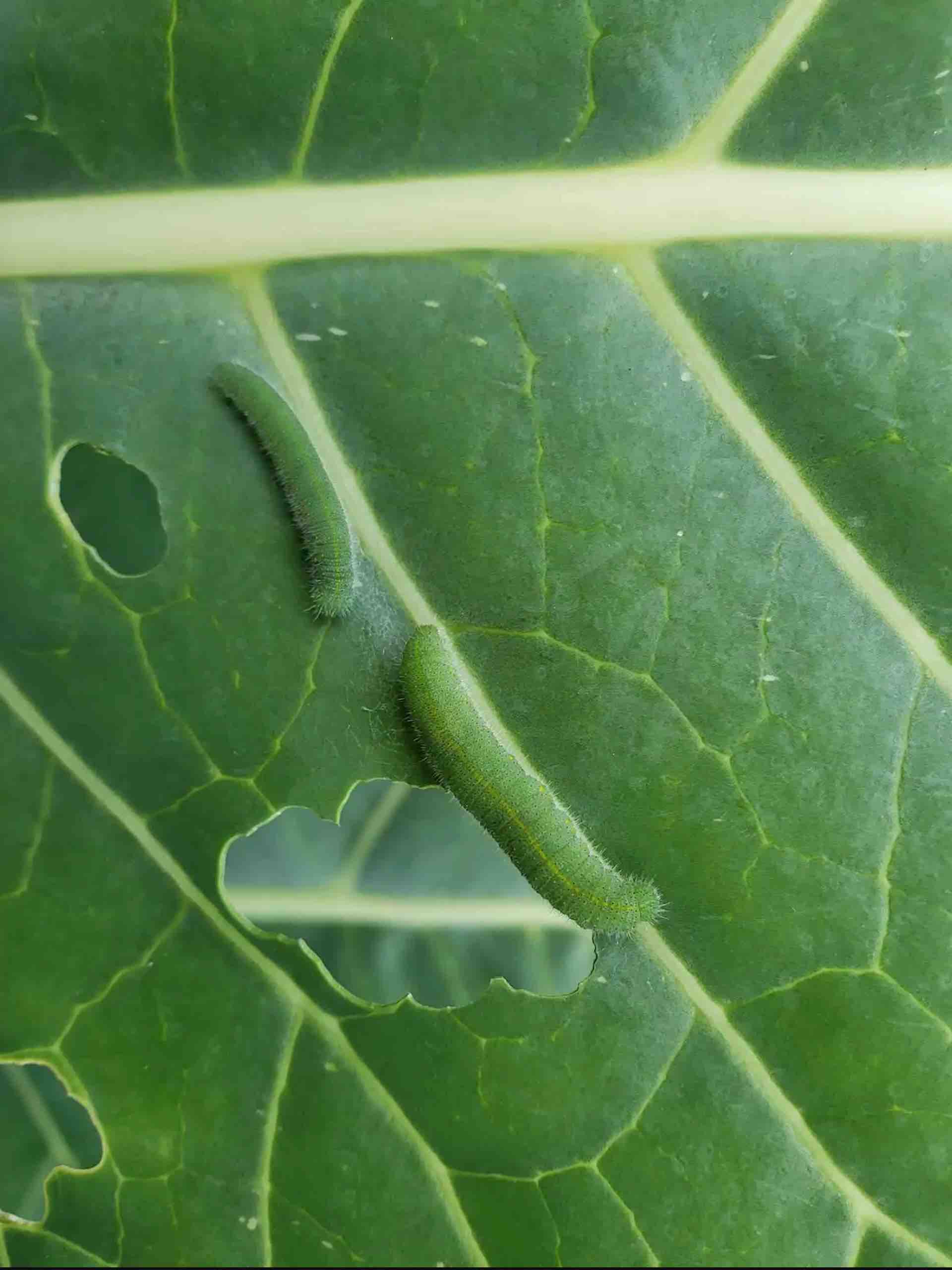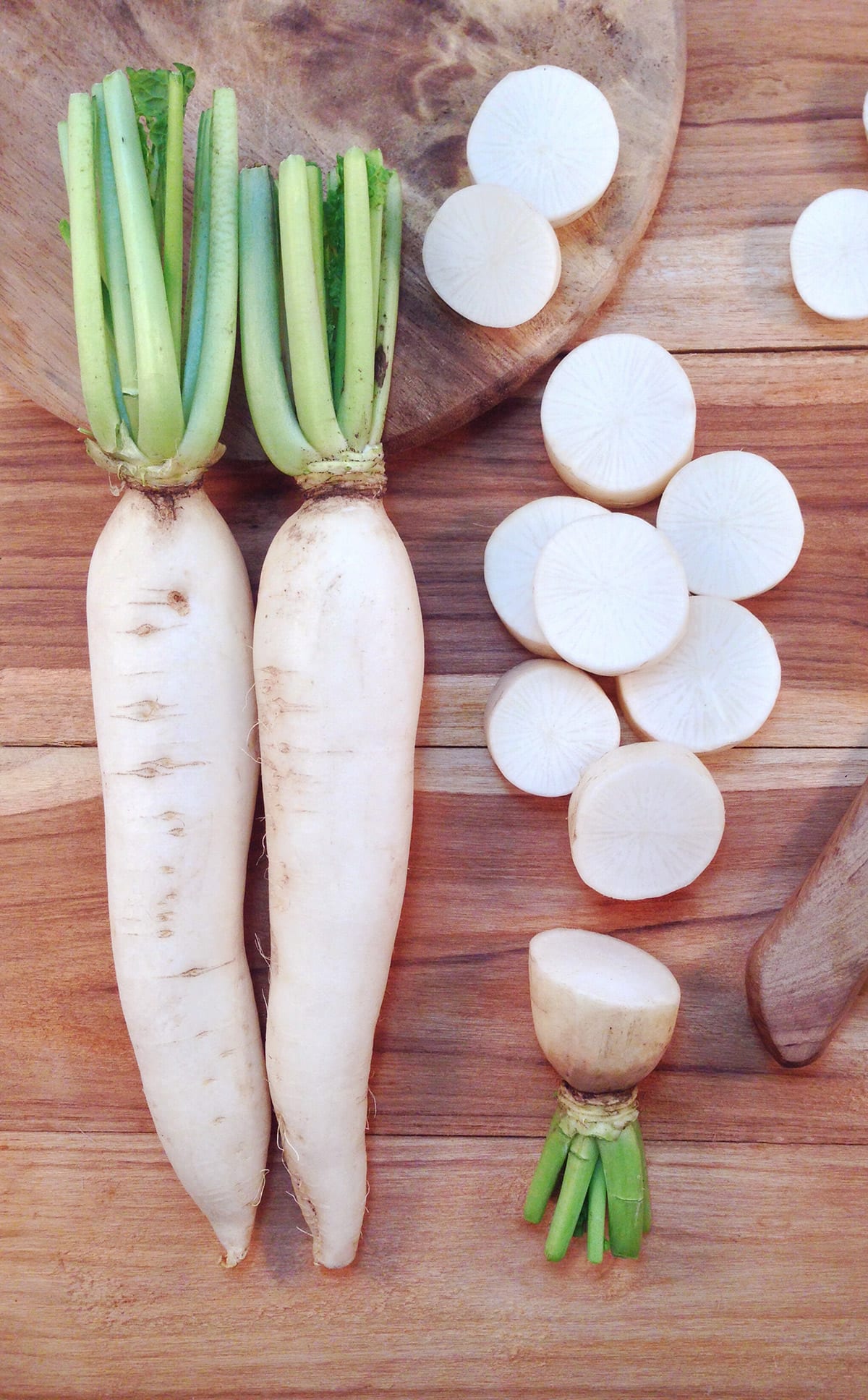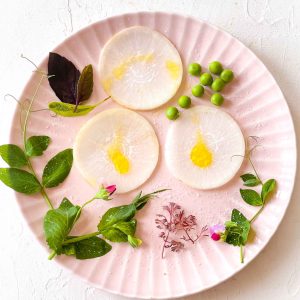How to Grow and Prepare Daikon Radish
Daikon radish, also known as Japanese radish or white radish, is a versatile root vegetable with a mild flavor and crisp texture, commonly used in various cuisines and culinary applications.
![]()

I’m obsessed with Daikon radish and all of its colorful variations. There are SO many ways to enjoy this versatile root vegetable!
Daikon radish, also known as Japanese or white radish, has a rich history dating back centuries. Originating in East Asia, specifically in regions such as China, Korea, and Japan, daikon radishes have been cultivated and enjoyed for their unique characteristics and culinary versatility. Throughout history, daikon radishes have held cultural and symbolic significance, representing prosperity, good luck, and cleansing properties. They have been incorporated into traditional cuisines, used in medicinal practices, and featured in various cultural celebrations and festivals. As their popularity spread, daikon radishes made their way to other parts of the world, gaining recognition for their mild flavor, crunchy texture, and potential health benefits. Today, daikon radishes continue to captivate palates worldwide, offering a refreshing addition to dishes, pickles, salads, and more. Embracing the rich heritage of daikon radishes allows us to appreciate not only their culinary contributions but also the cultural heritage and connections they bring to our tables.
You can see my Spring garden layout (including basil), seed choices, and each planting here in the Garden to Table section.

Reasons You’ll Love Growing Daikon Radish
Here are a few – all very beautiful and visually appealing!
-
- Abundant Harvest – Growing daikon radishes in your garden allows you to enjoy a bountiful harvest of these versatile root vegetables. With proper cultivation techniques and planting tips, you’ll be rewarded with an abundance of crisp and flavorful radishes that can be used in various culinary creations.
- Culinary Versatility – Daikon radishes offer endless culinary possibilities. From adding a refreshing crunch to salads and slaws to being pickled or used in stir-fries and soups, their mild flavor and crisp texture make them versatile ingredients that can elevate a wide range of dishes. Embrace the creativity in your kitchen and explore the culinary potential of homegrown daikon radishes.
- Nutritional Benefits – Growing daikon radish in your garden provides access to a nutritious and health-promoting vegetable. Daikon radishes are low in calories and rich in fiber, vitamins, and minerals, including vitamin C, potassium, and calcium. Incorporating these nutrient-dense radishes into your meals can contribute to a well-balanced and nourishing diet.
- Garden Variety – Adding daikon radishes to your garden expands the variety of vegetables you can grow and enjoy. With their distinct shape and color, daikon radishes bring visual interest and diversity to your garden beds. They can be grown alongside other vegetables, creating a vibrant and diverse garden space showcasing nature’s bounty’s beauty.
- Easy to Grow – Daikon radishes are relatively easy to grow, making them an excellent choice for beginner and seasoned gardeners. They can thrive in various climates and soil conditions with the proper planting tips and care. Their fast growth rate allows for a relatively quick harvest, providing a sense of accomplishment and satisfaction as you witness your garden yield a crop of fresh daikon radishes.
- Sustainable and Cost-Effective – Growing daikon radish in your garden promotes sustainability by reducing the need for store-bought produce, which often involves transportation and packaging. It is also a cost-effective option, as daikon radish seeds are typically affordable, and the yield from a well-maintained garden can supply you with ample radishes throughout the growing season.
- Gardening Connection – Growing daikon radish connects you to the earth and the rhythm of nature. Nurturing plants from seed to harvest fosters a deeper appreciation for the food we consume and the natural cycles of life. It provides an opportunity to engage with the outdoors, practice mindfulness, and develop a closer connection to the environment.
By embracing the journey of growing daikon radish in your garden, you’ll experience the joy of cultivating a nutritious and versatile vegetable, expanding your culinary horizons, and fostering a deeper connection with the natural world.

Popular Varieties of Daikon Radish
Here are some easy-to-grow varieties of daikon radish.
-
- Miyashige – This variety is a traditional Japanese daikon radish with a cylindrical shape and a length of about 18-24 inches. It has a crisp and mild flavor, making it versatile for various culinary uses.
- Long White – As the name suggests, this daikon radish variety features a long and slender shape, often reaching up to 2 feet long. It has white skin and a mild flavor, perfect for slicing and adding to salads or pickling.
- China Rose – This daikon radish variety has vibrant pinkish-red skin and crisp, white flesh. It tends to be shorter and rounder than other varieties, typically growing to about 6-8 inches long. China Rose daikon radishes have a slightly spicier flavor compared to other varieties.
- April Cross – Known for its fast-growing nature, the April Cross daikon radish variety is ready for harvest in 50-60 days. It is cylindrical, reaching about 10-12 inches in length. This variety has a sweet and mild flavor, making it suitable for raw consumption, pickling, or stir-frying.
- Watermelon – This unique daikon radish variety gets its name from its appearance, as it resembles a small watermelon. It has a greenish-white skin and a crisp, juicy flesh with a mildly sweet flavor. Watermelon daikon radishes are often used for their decorative value in salads and garnishes.
These are just a few examples of the many varieties of daikon radish available. Experimenting with different varieties can add excitement and diversity to your culinary creations, allowing you to explore the unique flavors and textures that each variety offers.

How to Grow Daikon Radish
Daikon radish is easy and fun to grow.
-
- Choose the Right Time – Daikon radishes thrive in cool weather, so plan your planting accordingly. Start early spring or late summer/early fall, depending on your climate. Avoid extreme heat or frost periods.
- Prepare the Soil – Daikon radishes prefer loose, well-draining soil. Work the soil to a depth of 8-10 inches, removing rocks and weeds. Amend the soil with organic matter, such as compost or well-rotted manure, to improve fertility and drainage.
- Select a Sunny Spot – Choose a location that receives full sun for at least 6 hours daily. Daikon radishes benefit from direct sunlight to develop their roots properly.
- Sow the Seeds – Directly sow daikon radish seeds into the prepared soil. Plant them at a depth of ½ to 1 inch and space them 4-6 inches apart. If planting in rows, maintain a row spacing of about 12-18 inches to allow room for the radishes to develop.
- Watering – Keep the soil moist but avoid overwatering, as excessive moisture can lead to rot or disease. Water deeply when needed, ensuring the soil remains evenly moist throughout the growing period.
- Thin the Seedlings – Once the seedlings have emerged, thin them out to provide adequate space for the remaining plants to grow. Thin the radishes to a spacing of 2-4 inches apart, allowing room for the roots to expand.
- Provide Adequate Nutrition – Fertilize the daikon radishes with a balanced organic fertilizer, following the package instructions. Apply the fertilizer when the plants have developed a few leaves and continue to fertilize every few weeks during the growing season.
- Weed Control – Regularly remove weeds around the daikon radish plants to prevent competition for nutrients and water. Mulching around the plants can help suppress weed growth.
- Pest and Disease Management – Monitor for common pests like aphids or flea beetles. Use organic pest control methods if necessary. Rotate crops and practice good garden hygiene to prevent diseases.
- Harvesting – Daikon radishes are usually ready for harvest within 45-60 days, but some varieties may take longer. Harvest when the radishes reach their desired size, typically around 6-12 inches in length. Gently pull them out of the soil, not damaging the roots.
By following these planting tips and caring for your daikon radish plants, you’ll be rewarded with a successful and bountiful harvest of these delicious and nutritious root vegetables.

Daikon Radish Pests and Bugs
Daikon radish can be susceptible to certain pests and bugs.
-
- Flea Beetles – These tiny jumping beetles can cause damage by chewing small holes in the leaves of your daikon radish plants. To control flea beetles, try using floating row covers to physically exclude them from your plants. Applying organic insecticides like neem oil or introducing beneficial insects like ladybugs can help combat flea beetle infestations.
- Aphids – Aphids are small, soft-bodied insects that can cluster on the leaves and stems of daikon radish plants, sucking sap and causing stunted growth. Regularly inspect your plants for aphids and remove them by spraying them with a strong stream of water or using insecticidal soap. Attracting natural predators like ladybugs or lacewings can help keep aphid populations in check.
- Cabbage Maggots – These pests attack the roots of daikon radish plants, causing wilting and yellowing. To prevent cabbage maggots, use row covers or erect physical barriers like collars around the base of your plants to block the adult flies from laying eggs near the roots. Practice crop rotation to reduce the risk of infestations.
- Slugs and Snails – These slimy creatures can chew on the leaves of daikon radishes, causing unsightly damage. Implement slug and snail control measures, such as placing copper tape or diatomaceous earth around the base of your plants to create a barrier. You can also handpick these pests when they are most active in the evening.
- Root-knot Nematodes – These microscopic worms can infect the roots of daikon radish plants, causing galls and stunted growth. Practice crop rotation and avoid planting daikon radishes in areas previously affected by nematodes. Soil solarization involves covering the soil with plastic to heat it and kill pests, and can also help manage nematode populations.
Regularly inspect your daikon radish plants for any signs of pests or bugs, and take proactive measures to prevent and manage infestations. By implementing these strategies, you can minimize damage and ensure the healthy growth of your daikon radish crop.

How to Prepare Daikon Radish
Preparing daikon radish is quite easy!
-
- Cleaning – Start by rinsing the daikon radish under cold water to remove dirt or debris. Use a vegetable brush to scrub the skin, gently cleaning it. Trim off any leafy greens or tough ends.
- Peeling (optional) – Depending on your preference and the specific recipe, you can peel the daikon radish using a vegetable peeler. Peeling can remove the outer layer, revealing the crisp white flesh beneath. However, keep in mind that the skin of daikon radish is edible and contains nutrients, so peeling is optional.
- Slicing or Dicing: Once cleaned and peeled (if desired), you can slice or dice the daikon radish according to your recipe’s requirements. Daikon radishes can be cut into rounds, julienne strips, or cubes, depending on how you plan to use them in your dish.
- Cooking Methods: Daikon radish can be prepared in various ways, depending on your culinary preferences. It can be enjoyed raw in salads, pickled for a tangy and crunchy condiment, or cooked in stir-fries, soups, stews, or roasted dishes. The mild flavor of daikon radish pairs well with various ingredients and seasonings.
- Serving Suggestions: Incorporate daikon radish into your favorite recipes for added flavor and texture. It works well in Asian-inspired dishes, such as stir-fry with other vegetables, noodles, or rice. Add daikon radish to salads, wraps, sandwiches, or as a side dish. Its versatility allows you to explore culinary possibilities and experiment with new flavors.
Daikon radish has a crisp and mildly spicy taste, so it can provide a refreshing and distinct element to your dishes. Enjoy the process of preparing daikon radish and let your culinary creativity shine as you incorporate this delightful root vegetable into your favorite recipes.

How to Store Daikon Radish
There are many ways to store daikon radish to preserve its flavor and extend its shelf life.
-
- Harvesting: When it’s time to harvest your daikon radish, gently remove them from the soil, not damaging the roots. Trim off the leafy greens, leaving about an inch of the stem intact.
- Cleaning: After harvesting, gently brush off any excess soil from the radishes. Please do not wash them, as moisture can promote spoilage during storage.
- Storage Options – Daikon radishes can be stored in multiple ways, depending on your preference and the available storage facilities:
- Refrigerator – Place daikon radishes in a perforated plastic bag or a loosely sealed container for short-term storage. Store them in the refrigerator’s vegetable crisper drawer. Properly stored, daikon radishes can stay fresh for up to two weeks.
- Root Cellar or Cool Storage: If you can access a root cellar or a cool, dark, and well-ventilated storage area, you can store daikon radishes there. Remove the leafy greens, place the radishes in boxes or baskets, and cover them with damp sand or sawdust to maintain moisture levels. Check regularly for any signs of spoilage or decay.
- Regular Inspection: Regardless of the storage method, inspecting the stored daikon radishes regularly is essential. Remove any radishes that show signs of rotting, soft spots, or mold to prevent them from affecting the others.
- Freezing (Optional) – If you have an excess of daikon radishes, you can also consider freezing them for long-term storage. Clean, peel (if desired), and cut the radishes into slices or cubes. Blanch them in boiling water for a few minutes, then cool them in an ice bath. Pat them dry and store them in airtight freezer bags or containers. Frozen daikon radishes can last for several months.
By following these storage tips, you can preserve the freshness and quality of your harvested daikon radishes, ensuring that you have a supply of this versatile root vegetable available for future culinary creations.

Serving Suggestions for Daikon Radish
Simple to prepare and wonderfully delicious!
-
- White Daikon Radish and Spring Pea Salad – This elegant salad is one of my Spring favorites. It’s delicious and elevates this root vegetable to new heights.
- Grain Bowls – Watermelon radishes make a perfect additional to any grain bowl.
- In a salad – One of my all-time favorite salads is my Spring Salad w/Watermelon Radish, Fresh Herbs, and Ricotta-Stuffed Pea Pods. Say no more!

White Daikon Radish and Spring Peas Salad
Ingredients
- 2 white daikon radish
- 1/2 cup spring peas, hulled and blanched
- 1 small bundle fresh herbs
- 2 sprigs purple dill
- sea salt
- extra-virgin olive oil
- pea shoots and flowers
Instructions
- Slice the daikon radish - about 1/8" thick. Arrange in the middle of the plate.
- Blanch fresh peas in hot water for about two minutes. Transfer to ice bath. Arranged on one edge of the plate.
- Wash and dry fresh herbs. Arrange three leaves on one edge of the plate.
- Snip purple dill which has been drying, but isn't fully dried. Arrange it on one edge of the plate.
- Arrange pea shoots and flowers in open spaces on the plate.
- Drizzle on extra-virgin olive oil.
- Sprinkle with sea salt.
- Add freshly ground black pepper.
- Serve immediately.


0 Comments